#moo studies science
Explore tagged Tumblr posts
Text
Let's talk about zoo animal welfare for a second...
(And I want to preface this by saying I have a 4 year Bachelor degree in Animal Science (focusing in welfare and behaviour with a major in Canine and Equine Science) before I got sidetracked into zoo animals and did 3 internships working with wild canids, ungulates and marine mammals - this involved both hands on behaviour modification/desenitisation as well as hands off behavioural observation and welfare study. I worked for 2 years as a marine mammal specialist and worked specifically in facilities to improve husbandry, behavioural training and welfare practises.
I also worked in a facility in the Asia Pacific, working to improve welfare standards for bottlenose dolphins and continued to work with cetacean welfare researchers after this. I also did a course in zoo management, husbandry and welfare and this involved working in an accredited zoo facility learning things like exhibit design, behaviour management and husbandry with multiple species.)
So a few points to say about zoo animal welfare when discussing zoo standards and practises:
The average person does not have the expertise to do behaviour observation and welfare evaluation in zoo animals - that's why when the general public visits a zoo and says "the animal looks sad" it's worth being skeptical of that claim. But it doesn't mean a gut feeling about a zoo's quality can be completely invalid. Just that it might be worth researching further or seeking more information.
However, with experience, it is possible to analyse behaviour in the context of welfare. And context to that behaviour is always important (for example, Moo Deng showing stress related behaviour towards the specific context of being touched or followed around by her keeper - very much an indication of poor handling practises)
Poor animal husbandry and welfare is not limited to specific countries or regions, however it can be more normalised and accepted under the influnce of cultures and laws. Or even just the culture of the zoo itself such as the "this is the way we've always done it" places.
Being an accredited zoo is a start to good welfare, but it doesn't make any sort of welfare concern obsolete. And accreditation is supposed to ensure that welfare concerns are addressed but because they are mostly run as a volunteer based organisation, they often don't have resources to check into every concern (unless it's a government funded organisation)
A zoo contributing to conservation research is great, but not if it is at the expense of the animals' welfare - welfare should always be prioritised, with research and conservation efforts to follow.
Welfare is a state that is in flux. So a negative welfare state can move into positive welfare state under different influences.
There are multiple factors that influence zoo animal welfare: enclosure/habitat, expression of natural behaviour, guest interaction, diet, enrichment, water quality, hygeine ect. It'll rarely just be one factor, though it does depend how salient that factor is.
Just because a keeper or management of a zoo have been there for a long time, doesn't mean they can't be criticised - it is possible to be still using outdated practises and believing in methodologies and management practises that need updating - that's the whole point of continued education
Having limited resources can often impact welfare. Giving a facility the resources they need to improve is a good start to improving welfare.
Even if an animal is being handled in an inappropriate way for a short time, that doesn't mean that can't have long term implications for welfare eg. if every time your dog jumped on you when you got home and you smacked him in the face once before going on with your day, that doesn't mean that your dog won't learn negative associations with your arrival just because it was one time.
Best practise husbandry of zoo animals involves:
Use of positive reinforcement based voluntary husbandry and health care
All interaction based on choice and voluntary interaction that is reinforced with primary reinforcement such as food
Mostly hands off approaches for the species that require them (ungulates, large primates, large carnivores)
Relatively stable social groups with aggression only in specific situations/contexts that are normal for the species
Back areas for animals to rest outside of public view
Species appropriate habitats to meet species specific behaviour requirements
Five freedoms of welfare being met but goes above and beyond the bare minimum
Poor zoo animal husbandry involves animals:
Being forced into anything such as presentations, education programs, medical procedures/gating
Any use of physical punishment such as chasing, slapping, pushing or poking - negative reinforcement such as bull hooks are also fairly outdated in handling species like elephants
Being excessively handled, chased and touched/restrained for no reason (eg. for social media videos)
Showing signs of avoidance and aggression constantly towards their keepers
Have constant conflict happening in their social groups
Are living in enclosures that are not suitable for their specific specific needs - size is only one factor in this. Substrate, habitat design, water quality ect. are also things to consider.
Are too close to the public/at risk from the public
Have no areas to retreat from the public/rest away from potential stressors
Have no enrichment program/no daily enrichment
Those are all flags that there could be some poor welfare happening and that a zoo is not prioritising welfare
Okay there's the ramble of the day done. Feel free to ask questions for further clarification if needed.
#I kind of hate when my posts break containment because it's a full time job trying to explain things to people who think they know better#zoo politics#animal welfare#zoo animal welfare#or want to bend over backwards to justify shitty animal husbandry because of whatever reason
1K notes
·
View notes
Text
The Science of Humane Slaughter
I asked an expert on humane livestock slaughter how we decided on certain methods of slaughter as more or less humane than others, from a scientific perspective.
He pointed me to this document (PDF) from the European Food Safety Authority called “WELFARE ASPECTS OF ANIMAL STUNNING AND KILLING METHODS:” Scientific Report of the Scientific Panel for Animal Health and Welfare on a request from the Commission related to welfare aspects of animal stunning and killing methods.
It's long, and old (from 2004) but it's a pretty useful document summarizing a lot of the science of why certain methods of killing may be more or less humane.
You can test a method, for example, by hooking an animal up to an EEG and monitoring its brainwaves after stunning it, or delivering a fatal blow (functionally killing it, but it won't always die instantly following a fatal injury, so you can still monitor it.)
Other ways of monitoring and measuring suffering include recording: how many times does an animal vocalize (moo, grunt etc) after being put in a chute? If it moves, does that matter, or is that a post-mortem or unconscious spasm? Does it immediately collapse, does it blink when you touch its eye (corneal reflex)? Is the animal permanently brain-damaged (which is a good thing when you want it to die fast!) or is it only a little knocked out and immobile, with the potential for recovery if you were to not bleed it out? (Which is bad in that circumstance!) A scientist can test that by testing a stunning method on a group of animals and then seeing if they recover. Those individual animals are likely not happy if they do return to consciousness with a hole in their heads, but such is science.
Anyway, while the testing might sound gruesome, I thought you'd like to know that slaughter regulations are pretty serious and well-studied. And those regulations seem pretty consistent among everywhere I've seen (EU, Norway specifically, the US.) With some minor differences here and there.
Perhaps we will discover better ways to slaughter meat animals in regard to their welfare, or perhaps we will find one day that our preferred method wasn't as good as we thought! There might also be people doing things in very bad, unintentionally cruel ways because of silly, disproven myths (but, if someone is legally selling meat, any US slaughterhouse is required to have a USDA rep see every death.)
I don't want to imply that every animal death goes perfectly well, or that it's even acceptable, or that the meat industry is perfect or good! But I do want to share that there is scientific precedent for why people kill livestock the ways they do, and you can read the studies in the aforementioned document. There are tons.
PS. If you have any interesting insights on the science of humane slaughter, I'd love to see them! Or, even, just tell me how it's done in your country, the role of the government, etc.
130 notes
·
View notes
Text
Why You Should Watch White Christmas (the 2011 Kdrama): A Manifesto
Yesterday I was watching White Christmas (specifically episodes 4 and 5) for the fourth time. I watched it for the first time like five years ago and all my feelings are still there and still potent so today I am here to tell you that you should watch it too.

THE BASICS:
Seven kids at an elite private high school over winter break. They stayed there because they all received mysterious black letters, accusing them of vague, nonspecific crimes and claiming that on New Year's Day someone will die. When they find out that ALL of them received this letter, they decide one of them must have been the one to send it--and they set out to discover who it was. In the meantime, a giant blizzard shuts down all the roads, and telephone and internet connections go down as well, leaving the school isolated and all on campus trapped there together.
things develop from there.
THE CHARACTERS:

Park Moo-yul: A Good Boy. His grades are constantly second highest in the school; he's obsessed with studying and wants to someday come in first. Sort of a leader type, he tries to organize the investigative efforts (and later, keep things from falling apart--except, much as he'd like to believe it, he's not immune to the Lord of the Flies effect lols). For the first couple episodes, he's sort of the main/POV character, but by the end it's more of an ensemble cast show. In the episodes I just watched, there are multiple scenes with him staring down a gun and waiting to get shot. Some ppl think he's boring but I love a guy with a hero complex.

Choi Chi-hoon: The Genius. The first place to Park Moo-yul's second. People call him unemotional and heartless; it turns out later he does have difficulty feeling emotions due to a neurological issue. Loves science, interested in the black letters as a puzzle but for a while pretends not to be. The least likely to go Lord of the Flies but his Very Logical plans are often actually very risky.

Yoon Eun-sung: The Only Girl. (except for that one other woman who shows up later but she's not one of the seven so we're not counting her.) Used to be the most popular girl in school and also Park Moo-yul's girlfriend but then she Changed (aka she developed depression). Sarcastic and possibly suicidal. Everyone is OBSESSED with her (well, four, arguably five characters are obsessed with her, but this show only has a total of 11 characters so that's really too many).
Also, she's played by Esom, so if you like Esom, you should watch White Christmas.
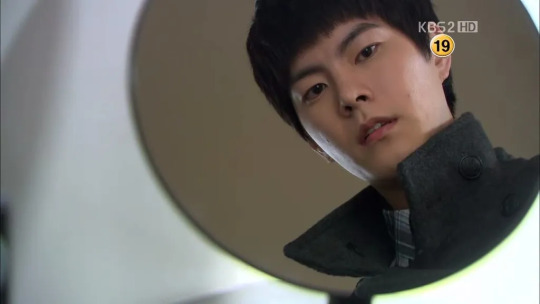
Lee Jae-kyu: Why are you here???? For the first few episodes, that's a genuine question; he doesn't have an apparent connection to the others in the group, and it's a mystery why the black letter sender would have any grudges against him. It turns out later he has some secret issues. He's a bit of a snake in the grass. I won't go into it.
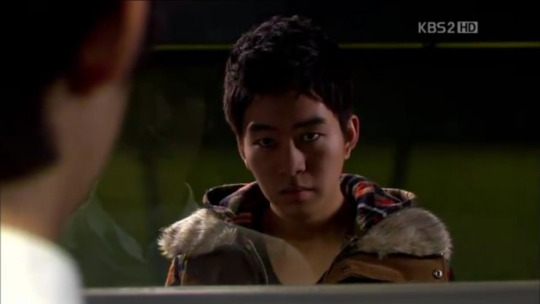
Yang Kang-mo: He wants to be a reporter someday! His nickname is Cameraman Yang, and he's always carrying a camera around. He's deaf, and partly as a result, gets bullied a lot. He is the favorite character of the friend I was watching this show with yesterday. Also there's a whole episode of him getting chased around with baseball bats, look forward to it.

Jo Young-jae: A bully, a coward and a messed up kid. A line he says in the show is, "Yes, I'm used to people hating me. To the extent that I'm scared when people don't hate me. But you made me hate myself!" A line someone else says to him is, "You're not a bad person. You're weak. If everyone knew how weak you were, they wouldn't hate you." To watch Jo Young-jae have multiple mental breakdowns, watch White Christmas, I promise it is very fun.
Also, he's played by Kim Young-kwang, so if you like Kim Young-kwang, you should watch White Christmas.

Yoon Su: His nickname is Angel. In general, it requires incredible academic acumen to go to Susin High; Yoon Su got in bc his parents donated money to the school. He's a loner and does not want to be here; his ambition in life is to be a musician, and he loves playing the guitar. He has some mental health issues and takes (unspecified) recreational drugs. He also has a giant grudge. Against who? Stay tuned to find out.
Also he's played by Lee Soo-hyuk, so if you like Lee Soo-hyuk, you should watch White Christmas.

Kang Mi-reu: THIS BOY IS NOT SUPPOSED TO BE HERE. Remember how I said seven kids got letters, seven kids stayed at the school? Meet kid number eight. Kang Mi-reu didn't get a letter and he didn't get permission to stay on campus either; technically he's on probation and on his way to being expelled. He sneakily stayed on campus to investigate who framed him for exploding a statue, the reason for his expulsion. He can go through air vents and has a great theme song. He wants to solve his problems with violence. Actually he once beat Choi Chi-hoon at academics but got pissed off at always losing to him and gave up on being a perfect student. We all love Kang Mi-reu.
Also he's played by Kim Woo-bin so if you like Kim Woo-bin, you should watch White Christmas.

Yoon Jong-il: The teacher who stayed on campus to supervise. Wow, I'm sure with a responsible adult around, there will be no chaos or violence breaking out on campus.

Kim Yo-han: He's not even affiliated with the school. He got in a car accident near it and then got stuck here due to the storm. He keeps getting concussions/broken bones/deadly fevers. Also, he's a psychiatrist, and finds all the weird shit going on at the school rather intriguing.
IS IT SHIPPY?
I mean, is there any actual romance? No.
Do we see slow burn friendships develop from suspicion to deep trust and affection over the course of the show? Also no.
Do I think some of these people should make out? Yeah.
A few ships I have specifically:
-Choi Chi-hoon/Park Moo-yul: Obvious rival ship, overemotional dude/kind of cold dude, leader type/genius type. There is also some hurt/comfort towards the end that I really can't describe without spoilers but the mix of resentment and trust is immense.
-Kang Mi-reu/Park Moo-yul: This is my just for fun ship. Good boy/bad boy vibes. Also Kang Mi-reu seems to actually listen to Park Moo-yul when for the most part he won't listen to anyone. Also he snuck into Park Moo-yul's bedroom once while he was sleeping and teased him about the fact that he and all the others got black letters and won't the sender be so offended he dares to sleep instead of sitting up paranoid all night. I just think they're cute.
-Yang Kang-mo/Jo Young-jae: Yes this is a bully/victim ship which is not usually my thing, but I love both of them and also Young-jae is so pathetic and Kang-mo honestly scares him at multiple points. Meanwhile Kang-mo is kind of tired and fed up with him but at this point has sort of a weird connection with him regardless. They know each other.
-Yoon Eun-sung/Jo Young-jae: Young-jae is my favorite of the dudes who's obsessed with Eun-sung, and the most toxic of them as well. She used to be perfect and he had a resentful crush on her for that; now she's kind of messed up but still aloof and superior, and he still wants and hates her at the same time. And she knows, and teases him about it, and he acts nonchalant but you can tell it grinds at him. The best m/f dynamic of the show.
I have a bunch of other ships.... explaining them involves spoilers so I'll just list a few: Kang Mi-reu/Yoon Su, Yang Kang-mo/Yoon Eun-sung/Park Moo-yul, Lee Jae-kyu/Choi Chi-hoon, Lee Jae-kyu/Jo Young-jae.
BUT, PERHAPS MOST IMPORTANTLY... THE VIBES!!!
I love the characters of White Christmas but I mostly rewatch it so much bc 1) the pacing is on point and 2) it's so cinematically satisfying.
In terms of plot and pacing--Everything moves fast. Each episode is very distinct from the others, the plot consistently moving forward at a breakneck pace. Each episode I would say gets a little faster and wilder (with the exception of episode 3, perhaps, which moves a little slow--but then episode 4 goes completely unhinged, so it's a fair exchange). There is shit going on and they are going to cram a whole show's worth of content into 8 episodes and you are going to eat it.
In terms of production: Visually stark. Lots of glass and snow and shadows everywhere. Fun shots. A great soundtrack. For one thing, Wake Up by Arcade Fire recurs a lot and the vibes are immense and very teenage angst and "what the fuck am I supposed to do".
Anyways here's some shots I think convey the vibe:

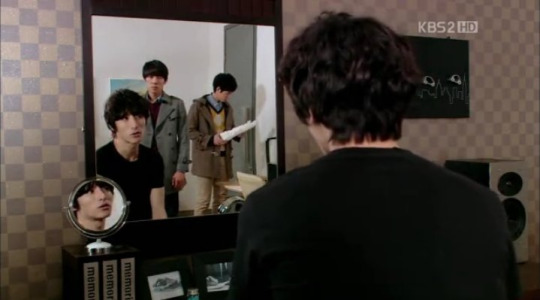





ANYWAY.
Watch White Christmas! And if you do, or if you've already watched it, please talk to me about it! I am currently in the White Christmas feelings, as I often am this time of year.
18 notes
·
View notes
Text
i asked a customer what milk he wanted and he said “the kind from an animal that goes moo, you young people may not know of that” so i just told him that i’m studying animal science and have been to multiple dairy farms bc even with my limited experience i have 100% spent more time around dairy cows than that man
#i hate condescending older customers#he did shut up when i said that tho so it worked#and then his wife was telling me how cool it is that i’m studying animals so
10 notes
·
View notes
Text
こんにちは, bonjour, or just a simple hello. My name is Victor Yamashita-Rousseau, I'm 34, use He/Him pronouns, and research Ghost Type Pokemon at the Lilycove Ecological Society. Most of my work has me up on Mt. Pyre, but I'm currently in Paldea teaching at Uva Academy.
Major Focus of my Studies:
The Natural Interactions of Ghost Types in the Wild.
The Origins of Human/Non-Human Ghost Types.
The Existence of Non-Pokemon Ghosts in Relation to Ghost Types.
Regional Ghost types and Their Cutural Mythology.
Trainer Card:

Look who's dragging Vic back to Tumblr! Meeee @awn-moo that's who! Anyway, just changed up his backstory, his current situation, and a little bit about his family. That will all be found out as I keep playing toys with him. Also! This will be very science/hc heavy, so be prepared for my infodumps about ghosts hehehe :3c
Alright! Rules:
- No sapient pokemon/legendaries - Be niceys - No explicit NSFW. There may be implied or subtle NSFW jokes and stuff made. But I will tag appropriately (Mun and Mod are 18+). - No Magic Anons/Pelipper Mail/Pelipper Malice/Musharna Mail - Have fun!! I missed Vic and am suuper excited to play him again!! So do enjoy!!
2 notes
·
View notes
Text
Musical Environments

Is there value in examining the intersection of sound and natural environments?
What do the subjects of music and natural resources share?
On the surface, there is little to connect between life sciences and performance arts. Some instruments are crafted from natural materials, though many in the modern day are not. Certainly many scientists happen to be musical, play an instrument, or perform in an ensemble, but their practice of self expression likely doesn't impact their profession.
In sincerity, the way these subjects relate to each other is of an abstract nature; these subjects inspire connection. Connection to self, connection to others, and connection to the environment. This series will illustrate several interdisciplinary practices that involve sound and the natural world.
Soundscapes

From birdsong choruses to the atonal cacophony of rush hour traffic, rarely is there a moment without music in the world.
Music is usually defined by human composition - the intentional application of music theory to make pieces using voice or instruments – but even modern musicians have challenged that expectation. A renowned work of the 20th century is 4’33 by John Cage, a work in three movements, where not a single note is played. Instead, a performer sits at a piano, opening and closing the hood to mark the different movements. Where is the music in this performance?
Whether in a concert hall or in the great outdoors, our day to day is saturated in sound. To describe the qualities of sound in a given area is to describe a soundscape.
Soundscapes are inherent to every environment. Factors like climate, geography, proximity to civilization, and wildlife will affect the unique sound signature of an area. These characteristics can be summarized in three parts; the biophony, the geophony, and the anthrophony ().
Sounds produced by “biological organisms” - from whale songs to bird songs, barnyard moos and thundering hooves- are all of the biophony. The geophony is sounds from “nonbiological sources” - the ambience of falling rain and thunderstorms, crackling fire, or wind singing through trees. Anthrophony was the most recent term to be defined, considered to be any sounds produced by humans and our tools. The anthrophony includes beautiful sounds, as we’ve crafted rich soundscapes of symphonies, though arguably, anthrophony is the most disruptive of the natural world, with noise pollution
The soundscape ecologist, Bernie Krause, pioneered these definitions. His work has used soundscapes to analyze trends in natural resources, many of his studies tracking animal populations through changes in their environment (for example, bird species present before/after a forest clear cut). Krause has spent his life and career recording soundscapes and using his experiences to bring awareness to the importance of sound in our surroundings.
These definitions provide a new framework to listening to the world around you. The anthrophony is colored with noise pollution, but also contains all composed and improvised music. John Cage’s 4’33 wasn’t a silent performance – the concert hall was filled with a cacophony of shuffling and murmurs, coughs and conversation. An act in three movements that centered on the anthrophic orchestration of the audience.
Composed Mindfulness

The natural world has inspired inspiration for music for time uncounted.
Within a vale of western mountains, a small cabin by Shotpouch creek hosted a unique experience - a meditation of sound. On a grassy knoll, a creek steadily bubbling nearby, and within walls of towering Douglas firs, a violin sang out into the clearing. This song had been primed with a call to awareness, to pursue immersion in the landscape and sounds.
This meditation was led by Rebecca Sabine - a professional musician, a mother, and a lifelong learner. Her career with the Las Vegas Philharmonic () has spanned 5 decades, allowing her to perform with artist like Frank Sinatra, Celine Dion, and Adele. Over the course of her life, her relationship to music has developed, unfurling into a journey that allows her to explore realms of self, musicianship, and community.
Rebecca has published several different works that utilize different compositional techniques to convey symbolism of place and inspire reflection.
Her album, Siloheuttes of Zion, was born after she experience Zion National Park, in Utah. Each song is connected to a part of that experience, and the songs are composed with different timbres and moods to convey an impression of the park. Each song is purely orchestral, program music.
Many of her pieces are meant to accompany meditation, and are published through her venture Violin Sound Sanctuary, or through the meditation app Insight Timer. These works often feature recordings of natural soundscapes, which center connection to nature as part of self reflection.
These are only a small part of her musical practice. The meditation of sound at Shotpouch Cabin was a true showcase of her talent - leading a guided meditation, with an improvised violin song in harmony with the environment around her. This craft invited the listeners into
Rebecca has cultivated a practice of mindfulness that utilizes several different compositional techniques to cultivate an environment of awareness. Her work inspires connection to self and the environment around you, regardless of in person performance or recording.
Rebecca Sabine performs her mindfulness workshops worldwide. She received her Bachelors from Oregon State University, and is currently pursuing a Masters at the Pacifica Graduate Institute.
Amplifying Science

Arts and science are often painted as subject in total opposition. Though, from common tools to industry innovations, theres many ways the two are used in synchronicity.
Using sound to convey data is not a new practice - from the clicks of geiger counters to illustrate radioactivity, to wind chimes that sing the intensity of the weather, data-sonfication is an emergent practice that has many applications. Large datasets converted to sound can help researchers find patterns, it can be used to introduce engineering and technology concepts in a way that engages creative thinking, and it can inspire collaboration between broad communities of arts and science.
Chet Udell, a researcher at Oregon State University, is in the process of developing a technology that sonifies data about climate. Udell is working on the development of “WeatherChimes”, a gadget that collects environmental data to be converted into musical material. This technology is already being used in a study about Alaska’s weather. Initial experiments have demonstrated how environmental phenomenon can resemble musical structures - inverse relationships such as temperature and humidity (ex. as temperature gets hotter there’s less moisture in the air) can be interpreted in similar patterns as proper counterpoint.
Victor Villegas is a technologist that works for the Oregon State Extension Service, and through his work and his mentorship, he advocates for comprehensive STEAM education, with an emphasis of reaching out to communities that have been underrepresented. Victor is familiar with many data-sonification technologies, including PlantWave. PlantWave is a gadget where you attach electrical nodes to leaves of a plant. It measures the electric signal between the nodes, which fluctuates from a plant photosynthesizing, growing, or responding to it's environment. The electrical signals are interpreted through a simple user interface to create music. Victor uses PlantWave to engage with students that are interested in science or creative projects.
A final example of data-sonification comes from the University of Florida usic department. In a collaboration with a researcher who studies red algae blooms and coral reef health, they composed a piece in two parts - Sanctuary, a percussive section that represents data of coral reefs, and Cardinal Flow, a wind ensemble section that illustrates tension and dissonance born from the effects of red algae blooms. This collaboration led to the founding of the group CRESCENDO - Communicating Research Expansively through Sonification and Community-Engaged Neuroaesthetic Data-literacy Opportunities.
Data-sonification can be applied to any field or research that works with data. Incorporating sound into science, this interdisciplinary approach is already driving innovation.
An Invitation to Community

Through harmonies or lyrics, music is valuable in how it inspires connection. This segment is not to examine a composition, but to examine how sharing a listening contributes to a culture of connection.
Corvallis, Oregon, nestled in the Mid-Willamette Valley, bears a rich ecological history shaped by the stewardship of the Kalapuya people and neighboring tribes. Traditionally, these indigenous communities managed the land to sustain diverse ecosystems, but the arrival of settlers displaced them and disrupted the ecology of the Valley. In the last 200 years, western Oregon has been divided between industries of logging, farming, and manufacturing, and further subdivided between cities and suburbs. Despite, or because of this industrialization, there’s innumerable efforts to encourage sustainable natural resource management.
It is a difficult task to negotiate ecological restoration between the patchwork of public and private landowners. Beyond the task of any individual, grassroots community organizing has become pivotal in shaping the landscape.
Land trusts are a type of non-profit organization that can facilitate large scale habitat restoration by collaborating with landowners to conserve ecologically important areas, as well as providing educational and recreational opportunities for their local communities. In the Mid-Willamette Valley, Greenbelt Land Trust conserves over 5500 acres between the Eugene and Salem areas, encompassing riversides, wetlands, woodlands and more. Besides stewarding these diverse ecosystems, Greenbelt makes a considerable effort to engage with their local community, taking form in wildlife walks, volunteer native plant cultivation, and outreach events hosted on their properties.
One such event is a concert hosted on Bald Hill Farm, a property owned by Greenbelt and connected to the city of Corvallis through trails open to bikers and hikers. The first concert premiered as Symphony on the Land, a collaboration with the Oregon State Symphony, where classical musicians arranged in a cow pasture, performing for picnickers and volunteers. Symphony on the Land was organized shortly after Greenbelt purchased the Bald Hill Farm property in 2013. The property is a short distance away from the Benton county fairgrounds, and is connected to the city of Corvallis through accessible hiking trails. Since it’s inception, concert-goers are encouraged to embrace sustainable modes of transportation, whether hiking, biking, or utilizing shuttles from the nearby Benton County Fairgrounds.
As with many events, The COVID-19 pandemic interrupted the concert's continuity. The current Outreach Coordinator, Matt Benotsch, came into his role in Winter 2020, and has had to rebuild this event from the ground up.
Matt's philosophy for community engagement is centered on inclusivity, with extreme care given to how language shapes awareness. Beginning in 2020, Symphony on the Land was retitled to Music on the Land – in part because the 2020 performance was recordings of individual musicians rather than a full symphony, but also from the recognition that symphonies and classical music hold an association with intentionally exclusionary histories and cultures.
Since 2022, Music on the Land hosts multicultural ensembles, who’s sounds harmonize with the audience and ambience of the event. This year, the concert will open with Corvallis' women's choir Jubilate! The headliner, Outer Orbit, is a soul/funk band from the Portland area, and the DTW Street Band is meant to inspire some movement, playing New Orleans style jazz.
The role of Music on the Land is not necessarily to promote Greenbelt or to fundraise. As Matt puts it, the concert is “a celebration of conservation and community”. Allowing people to bask in the beautiful space of the foothills of Corvallis, anyone is welcome to attend, and hopefully the experience allows them to connection to their community and surroundings.
Greenbelt's commitment to grassroots activism is embodied in initiatives like Music on the Land. Simply from sharing space and sound, the event promotes awareness and appreciation for the local environment, helping cultivate a community of change.

To Conclude
What could be valuable in examining the intersection of sound and natural environments? What does music and natural resources share?
Through this series, we've seen creative ways that sound inspires awareness, connection, and community. Humans have never been independent of the natural world - we are a a keystone species that has a unique power to cultivate our surroundings.
Be observant of sound. Explore community and find opportunities to connect to others.
This work was composed as part of a class at Oregon State University, and was informed by many community members from the Willamette Valley.
Sources :
1. Pijanowski, B. C., Villanueva-Rivera, L. J., Dumyahn, S. L., Farina, A., Krause, B. L., Napoletano, B. M., Gage, S. H., & Pieretti, N. (2011). Soundscape Ecology: The Science of Sound in the Landscape. BioScience, 61(3), 203–216. https://doi.org/10.1525/bio.2011.61.3.6
2. Gray, P. M., Krause, B., Atema, J., Payne, R., Krumhansl, C., & Baptista, L. (2001). The Music of Nature and the Nature of Music. Science, 291(5501), 52–54. http://www.jstor.org/stable/3082167
0 notes
Text
Study MBBS in Kazakhstan: A Comprehensive Guide for Aspiring Medical Students

Choosing the proper goal for pursuing an MBBS degree is significant for any medical hopeful. Kazakhstan has developed as a prevalent choice for students around the world, particularly from India, due to its high-quality education system, reasonable fees, and state-of-the-art framework. This article gives an in-depth look at examining MBBS in Kazakhstan, covering angles like fees, top universities, and the admission process.
Why Study MBBS in Kazakhstan?
Kazakhstan offers various advantages for students looking to study MBBS abroad:
Affordable Fees: Compared to nations just like the USA and UK, MBBS fees in Kazakhstan are altogether lower, making it a cost-effective choice for many students.
High-Quality Education: The nation has a few top-ranked medical colleges with cutting edge offices and experienced staff.
Acknowledgment: Medical colleges in Kazakhstan are recognized by major worldwide organisations like WHO, UNESCO, and the Medical Board of India (MCI).
Cultural Diversity: Kazakhstan is domestic to a different student populace, advertising a rich social involvement.
Best Medical Universities in Kazakhstan
Al-Farabi Kazakh National University
Al-Farabi Kazakh National University is one of the driving medical schools in Kazakhstan. Known for its excellent scholarly environment and research offices, this university is a top choice for many worldwide students.
South Kazakhstan Medical Academy
Another prestigious institution is the South Kazakhstan Medical Academy. The foundation is eminent for its progressed educational modules and advanced educating strategies, planning students for fruitful medical careers.
MBBS Fees in Kazakhstan
One of the foremost appealing aspects of examining MBBS in Kazakhstan is the reasonable educational cost fees. Normally, the yearly educational cost fees extend between $3,000 and $5,000. Moreover, the taking a toll of living in Kazakhstan is generally moo, making it an financially practical alternative for many students.
Expense Structure Overview
Educational cost Expenses: $3,000 - $5,000 per year
Settlement: $700 - $1,000 per year
Random: $500 - $800 per year
MBBS Admission in Kazakhstan
The admission process for MBBS in Kazakhstan is straightforward and hassle-free. Here a step-by-step guide:
Eligibility Criteria
Academic Requirements: Students must have completed their higher secondary education (10+2) with Material science, Chemistry, and Science as fundamental subjects.
Least Marks: A least total score of 50% in PCB (45% for saved categories) is required.
Entrance Exams: A few universities might require students to clear entrance exams like NEET.
Application Process
Research and Shortlist: Distinguish the medical colleges in Kazakhstan that coordinate your preferences and requirements.
Application Form: Fill out the application shape of the chosen university and yield the vital records (stamp sheets, visa, etc.).
Admission Letter: Upon survey, the university will issue an admission letter on the off chance that the student meets the eligibility criteria.
Visa Application: Apply for a student visa with the admission letter, visa, and other required documents.
Travel and Accommodation: Once the visa is approved, make travel arrangements and secure convenience in Kazakhstan.
Medical Colleges in Kazakhstan for Indian Students
Kazakhstan is especially prevalent among Indian students due to a few factors:
Comparative Educational modules: The MBBS educational modules in Kazakhstan are similar to that of Indian medical colleges, guaranteeing smooth move and understanding.
MCI Recognition: Many Kazakh universities are recognized by the Medical Council of India, empowering students to practise in India after completing their degree.
Cultural Affinity: The presence of a significant number of Indian students makes a recognizable environment, facilitating the social move.
Conclusion
Kazakhstan stands out as a premier goal for aspiring medical experts. With reasonable MBBS fees, top-notch universities like Al-Farabi Kazakh National University and South Kazakhstan Medical Academy, and a clear admission process, it offers a great opportunity for students to realise their medical goals. On the off chance that you're considering examining MBBS abroad, Kazakhstan merits genuine thought for its quality education and economic possibility.
For more detailed data and help with MBBS in Kazakhstan, feel free to reach out to educational experts or specifically visit the official websites of the universities specified.
0 notes
Text
MBBS in Russia: A Comprehensive Direct for Yearning Medical Students
Russia has risen as a prevalent goal for worldwide students looking to seek an MBBS degree. With a wealthy history in medical education, reasonable educational cost expenses, and universally recognized degrees, Russian medical universities pull in thousands of students from around the world each year. This article dives into the different angles of examining MBBS in Russia, giving a comprehensive direct for trying medical students.

Why Select Russia for MBBS?
High-Quality Education
Russian medical colleges are eminent for their tall guidelines of education. Many colleges have a long history of brilliance in medical preparation and investigation. Teachers such as Moscow State Medical University, Holy Person Petersburg State Pediatric Restorative College, and Kazan Government College are known for their thorough scholarly programs and state-of-the-art offices.
All inclusive Recognized Degrees
Degrees from Russian medical universities are recognized by major worldwide organizations such as the World Well Being Organization (WHO), Medical Council of India (MCI), and different other worldwide medical sheets. This worldwide acknowledgment guarantees that graduates can hone medicine in their domestic nations and somewhere else after passing the vital licensing exams.
Reasonable Educational cost Expenses
One of the foremost compelling reasons to think about MBBS in Russia is the affordability. Educational cost expenses in Russian medical universities are altogether lower than those in many Western nations. Moreover, the taking a toll of living in Russia is moderately moo, making it an financially viable option for many students.
English-Taught Programs
Many Russian universities offer MBBS programs in English, disposing of the language boundary for international students. This makes it easier for students from non-Russian talking nations to adjust and succeed in their studies.
Admission Process
Eligibility Criteria
The basic eligibility criteria for admission to an MBBS program in Russia include:
Scholarly Prerequisites: Understudies must have completed their higher auxiliary education (10+2) with a least of 50% marks in Material science, Chemistry, and Science.
Age Constrain: The student should be at least 17 a long time ancient by the 31st of December of the admission year.
Entrance Exam: A few colleges may require students to pass an entrance exam, although many don't have such a requirement.
Application Method
Inquire about and Select Universities: Begin by inquiring about the universities advertising MBBS programs and select the ones that best fit your needs.
Fill Out the Application Shape: Total the application frame accessible on the university's official website.
Yield Required Reports: Yield the necessary records, counting scholarly transcripts, visa duplicates, and photos.
Get Admission Letter: Upon acceptance, the university will issue an admission letter.
Apply for Visa: Apply for a student visa at the Russian embassy or department in your nation.
Get ready for Departure: Once the visa is allowed, make travel courses of action and plan for your move to Russia.
Required Reports
International id (with at slightest 18 months legitimacy)
Birth certificate
10th and 12th-grade check sheets
Passport-sized photos
Admission letter from the college
HIV test report
Wellbeing insurance
Curriculum and Length
The term of the MBBS program in Russia is ordinarily six a long time, counting one year of internship. The educational module is isolated into two primary parts: pre-clinical and clinical.
Preclinical A long time
The primary three a long time center on hypothetical and crucial restorative sciences such as Life systems, Physiology, Natural chemistry, Pathology, Microbiology, and Pharmacology. Students moreover learn the nuts and bolts of medical practice and morals.
Clinical A long time
The final three are committed to clinical preparation, where understudies pick up hands-on involvement in various departments of hospitals under- the supervision of experienced specialists. Clinical subjects include Common Medicine, Surgery, Pediatrics, Obstetrics and Gynecology, Psychiatry, and more.
Life in Russia for Universal Students
Accommodation
Most universities give lodging offices for international students. These lodgings are equipped with essential amenities and give a conducive environment for considering. Private convenience alternatives are too available for those who prefer more independence.
Cost of Living
The cost of living in Russia is generally low compared to Western countries. Normally, students may require around $150-300 per month for living costs, counting food, transportation, and other personal needs.
Cultural Experience
Examining in Russia offers a one of a kind social involvement. Students get the opportunity to associate with peers from distinctive parts of the world, learn approximately Russian culture and traditions, and indeed choose the Russian language.
Safety
Russia is for the most part secure for international students, with universities taking uncommon measures to guarantee the security and well-being of their understudies. It is, in any case, advisable to be aware of and follow the local laws and customs.
Post-Graduation Opportunities
Authorizing and Practice
After completing their MBBS in Russia, graduates must pass the licensing exam in their domestic nation to practice medicine. For this reason, Indian students have to clear the Outside Medical Graduates Examination (FMGE) conducted by the Medical Council of India (MCI).
Further Studies
Graduates can also opt for further studies, such as specialization in different areas of medicine. Russian universities offer a range of postgraduate medical courses, and degrees from these teachers are recognized around the world.
Career Prospects
An MBBS degree from a Russian university opens up various career opportunities. Graduates can work in hospitals, clinics, investigate, teach, and open health organizations. They can also pursue careers in medical education or healthcare administration.
Challenges and Considerations
Language Barrier
Whereas many universities offer programs in English, learning fundamental Russian can be advantageous for day-to-day intelligent and clinical practice. A few universities may include Russian language courses in their curriculum.
Climate
The Russian climate can be challenging for students coming from hotter districts. Winters are long and cold, so it's vital to be prepared and contribute to proper winter clothing.
Homesickness
Living absent from home in an outside nation can be difficult. Staying associated with family and companions, taking an interest in social activities, and seeking support from fellow students can help ease homesickness.
Conclusion
Seeking an MBBS in Russia offers various advantages, including high-quality education, reasonable educational cost fees, and all inclusive recognized degrees. With a well-structured curriculum, different social encounters, and promising career prospects, Russia stands out as a favorable goal for aspiring medical experts. However, it is basic for students to thoroughly research and consider all viewpoints before making a choice. By doing so, they can ensure a fulfilling and improving educational travel in one of the world's driving medical education hubs.
0 notes
Text
In the Heart of the Himalayas: MBBS Education in Nepal
Nepal, a arrival of breath taking scenes and social diversity, isn't as it were a tourist goal but moreover a hub for medical education. Among its locales, Nepal stands out as a promising goal for pursuing an MBBS degree. With its scenic excellence and burgeoning medical foundation, Nepal offers both opportunities and challenges for aspiring medical students.

Openings:
Affordable Education: One of the most appealing perspectives of studying MBBS in Nepal is its reasonableness. Compared to many Western nations and indeed a few Asian counterparts, the cost of medical education in Nepal, especially within the northern districts, is altogether lower. This makes it open to a wider run of students, including those from economically disadvantaged backgrounds.
Quality Education: Despite the lower cost, the quality of medical instruction in Nepal is commendable. A few medical colleges in cities like Kathmandu, Pokhara, and Biratnagar offer MBBS programs that are recognized by universal medical bodies. These colleges frequently have experienced faculty individuals and present day offices, guaranteeing that students get a well-rounded instruction.
Different Clinical Exposure: Nepal's differing scene, extending from the fields of the Terai region to the Himalayan mountains, gives medical understudies a special opportunity for clinical exposure. They encounter a wide assortment of medical conditions, from tropical illnesses prevalent in the swamps to altitude-related illnesses within the mountainous regions. This exposure improves their clinical skills and prepares them for differing medical challenges.
Social Submersion: Considering MBBS in Nepal isn't around scholastics; it's moreover a social travel. Northern Nepal is domestic to different ethnic bunches, each with its own traditions, languages, and healthcare practices. Submerging oneself in this wealthy social embroidered artwork not as it were broadens one's perspective but also cultivates social competency, an essential trait for healthcare experts in today's globalised world.
Challenges:
Framework and Assets: Whereas Nepal offers quality medical education, a few districts still confront challenges in terms of infrastructure and assets. Inaccessible areas, particularly within the Himalayan locale, may need satisfactory healthcare offices and gear. This will restrain students' presentation to progressed medical homes and innovations.
Language Boundary: Although English is broadly spoken in Nepal, dialect boundaries can still pose challenges, particularly in provincial areas where local tongues are predominant. Whereas most medical colleges offer instruction in English, students may experience troubles in communicating with patients and understanding nearby healthcare homes in non-urban settings.
Adjustment to Climate and Height: Nepal's different geology means that students may have to adjust to shifting climatic conditions and heights. The Terai locale experiences hot and sticky climate, whereas the Himalayan locale has cold temperatures and moo oxygen levels due to tall altitude. Adapting to these environmental factors can be physically demanding and may influence students' health and well-being.
Authorising and Acknowledgment: Graduating from a medical college in Nepal does not consequently ensure recognition in other nations. Understudies trying to practise medication universally may need to fulfil extra authorising necessities and examinations, which can be a complex and time-consuming process.
Exploring Three Chief Medical Colleges in Nepal
Nepal, eminent for its dazzling scenes and wealthy social legacy, is additionally getting to be progressively recognized for its brilliance in therapeutic instruction. Among the plethora of medical colleges within the nation, Manipal College of Medical Sciences, Lumbini Medical College, and Kathmandu Medical College stand out as chief teachers, each offering one of a kind openings for aspiring medical experts.
Manipal College of Medical Sciences (MCOMS):
Found in Pokhara, one of Nepal's most picturesque cities nestled within the lap of the Himalayas, Manipal College of Medical Sciences (MCOMS) could be a famous title in medical instruction. Established in 1994, MCOMS has reliably upheld its reputation for brilliance, drawing in students from Nepal and around the world.
Scholarly Fabulousness: MCOMS offers a comprehensive range of undergraduate and postgraduate medical programs, counting Bachelor of Medication and Bachelor of Surgery (MBBS), Specialist of Medication (MD), and Ace of Science (MS) degrees. The college has a team of highly qualified staff individuals who are committed to giving quality education and cultivating investigation and advancement within the field of medicine.
State-of-the-Art Offices: MCOMS is prepared with cutting edge offices, counting well-equipped research facilities, progressing medical innovation, and an open library supplied with an endless collection of medical writing. The college too gives students with adequate openings for hands-on clinical preparation through its affiliated hospitals and healthcare centres.
Worldwide Collaboration: MCOMS has manufactured associations with prestigious medical schools and universities around the world, encouraging student trade programs, collaborative research ventures, and workforce improvement activities. This worldwide viewpoint upgrades the scholarly involvement of students and uncovered them to assorted medical practices and perspectives.
Lumbini Medical College (LMC):
Situated in Palpa, a scenic town in Western Nepal famous for its social legacy and common beauty, Lumbini Medical College (LMC) is a driving institution in medical instruction and healthcare services.
Holistic Instruction: LMC is committed to giving an all encompassing instruction that not only focuses on academic greatness but too emphasises moral values, compassionate persistent care, and community engagement. The college's educational modules are outlined to instil basic thinking, problem-solving aptitudes, and polished skill in its students, planning them to excel as competent and compassionate healthcare experts.
Clinical Exposure: LMC offers broad clinical exposure to its students through its partnered educating hospitals and healthcare centres. Students have the opportunity to work beneath the direction of experienced clinicians, gaining hands-on encounter in diagnosing and treating a wide extent of medical conditions. This clinical exposure is instrumental in sharpening students' clinical abilities and planning them for the challenges of real-world medical practice.
Research and Innovation: LMC is effectively included in investigate and development activities pointed at progressing medical information and making strides healthcare results. The college empowers students and workforce individuals to lock in in research ventures, distribute logical papers, and take part in conferences and workshops. By cultivating a culture of research and development, LMC contributes to the progression of medical science and the change of healthcare conveyance in Nepal and the past.
Kathmandu Medical College (KMC):
Situated within the heart of Kathmandu, Nepal's capital city, Kathmandu Medical College (KMC) is a prestigious institution known for its academic greatness, state-of-the-art infrastructure, and commitment to serving the community.
Comprehensive Educational programs: KMC offers a comprehensive educational module that covers all viewpoints of medical education, counting basic sciences, clinical turns, and down to earth preparation. The college's experienced faculty members employ innovative teaching methods to guarantee that students get a well-rounded instruction that plans them for the challenges of cutting edge healthcare practice.
Clinical Preparing: KMC gives students broad clinical preparation through its associated educating clinics, which are prepared with progressed medical offices and staffed by experienced healthcare experts. Students have the opportunity to pick up hands-on involvement in different medical specialties, counting surgery, inner medicine, paediatrics, obstetrics and gynaecology, and psychiatry.
Community Engagement: KMC is effectively included in community engagement initiatives pointed at improving open wellbeing and healthcare access in Nepal. The college organises health camps, awareness programs, and outreach exercises in collaboration with local communities, government offices, and non-profit organisations. By actively engaging with the community, KMC contributes to the promotion of health and well-being at the grassroots level.
Conclusion:
In conclusion, pursuing an MBBS in Nepal offers a blend of affordability, quality education, diverse clinical exposure, and cultural immersion. Manipal College of Medical Sciences, Lumbini Medical College, and Kathmandu Medical College stand out as premier institutions, each with its unique strengths and contributions to medical education and healthcare in Nepal. With their commitment to excellence, state-of-the-art facilities, and community engagement, these colleges prepare aspiring medical professionals to excel in their careers and make a meaningful impact on healthcare outcomes, both locally and globally.
#MBBS in Nepal#Study mbbs in Nepal#MBBS fees in Nepal#Best medical university in Nepal#Medical colleges in Nepal for indian students#mbbs admission in Nepal
0 notes
Text
Animals and Anxiety

With Christmas just around the corner, Its time to reflect and yet we feel slightly empty in our home this year. Its been nearly a year now since we had to say goodbye to our Moo and sometimes I still hear him scratching on my door at night or see him out the corner of my eye. It’s strange the effect pets have on us as humans, though not in our life for very long they still have a long lasting effect on us. They become part of our homes and our families. They have personalities. Funny traits. Emotions. But why? Why do they invade our homes and settle and become part of us? How do they have this emotional effect on us and our families? And why do we like it? Well, I recall evenings during my childhood when I was sad my cat would immediately know if I wasn’t happy and would be by my side. If it was in the evening and I was in bed he would stay with me until I fell asleep. But how do they know? That’s the one thing I could never understand. How did he have such a soothing effect on me without even uttering a word. Just his presence alone was enough to sooth me. But how?
The science behind it
It has been proven scientifically that animal petting helps reduce the stress hormone Cortisol. Specifically the act of petting causes physical changes within the body from reducing cortisol to increasing the endorphin levels within the body. But why? I find that the physical touch is the reason for this as the soft feeling of an animals fur acts as a soothing stimuli much like a teddy bear or soft animal. The physical touch creates a soothing effect as a release of oxytocin is also a result. Further helping in reducing stress levels. Studies have shown that they provide a happy effect on those who are disabled aiding them in increased levels of smiling and speech where having a pet dog has led to them wanting to interact with people more.
Unconditional Love
Furthermore to this, pets have an unconditional love bond to their owners. They don’t judge us for the things we do or say. They offer unconditional love and acceptance to us. This reduces stress too as it provides us a small sanctuary where there is always our pet at home which gives us a somewhere to go regardless of our actions. They are always there for us even in our darkest times let alone our best times. We nurture and protect them and in turn they offer us loyalty. They are out little sidekick who is always by our side waiting for us to come home from work or school. It has been said that if an owner dies in their home a dog will lay down next to them and die too as they cannot get food or water anymore. In Edinburgh there was a dog called the Greyfriars Bobby and he spent 14 years guarding his dead owners grave until his own death in 1872. Never leaving his owners side even in death.

Mindful effects
Their presence alone can act as a method of mindfulness. Interactions with them can act as a way of grounding yourself and being in the present as it is just you and your pet. No other external distractions just the two of you. It not even physical touch that creates this effect but also the physical activity which accompanies it as daily walk and playing. Providing a distraction to allow for the mind to rest. Creating a calm and trusted environment knowing that no matter what your pet will be there for you regardless creating a restful environment where one can recharge and re-energize.
But how do we get to this point? How do they work their way into our hearts and homes? There’s a feeling of responsibility and purpose we receive from welcoming them into our new homes like a new-born baby. As when owning a pet it comes with all the responsibility similar to having a child. They need to be feed, played with, exercised or bathed. All are important activities which need to be done almost daily when owning a pet. By doing so we feel a sense of accomplishment and responsibility as their living and happiness depends on you. Allowing for us to feel as though they are our own little child which we have to look after. Making them part of our family no matter how big or small.

Well, when looking at this overall it is clear to see that we love and care for our animals like they are part of our family. Acting as emotional expressors where they allow for us to express all our emotions good and bad through their companionship. They allow for a space to release our emotions as well as giving us a sense of pride and responsibility. From giving us unconditional love, always being there for us, giving us something to care for and be there for them in return. They give us a place to express how we feel, spend time with exercise and feel at home with. That sense of security that only family can provide. Giving us a sense of purpose and companionship. And as the year comes to a close that’s what I’ve been missing this last year. My little furry friend waiting for me at the door when I come home. Or giving me a morning/bedtime cuddle. Even if he could have been a pain in my arse a few times it never mattered because he loved me and I him. He was always there for me when things went wrong. An invisible presence that even if he wasn’t in the room you could still feel that he was here. Where now the silence is deafening. He truly is gone but he is and will always be part of our family.
0 notes
Photo

4/6/18
Let SWOTVAC begin
66 notes
·
View notes
Text
YAY I FINISHED MY HISTORY PROJECT
1 note
·
View note
Text
Balaeniceps rex

By Olaf Oliviero Riemer, CC BY-SA 3.0
Etymology: Whale Head
First Described By: Gould, 1850
Classification: Dinosauromorpha, Dinosauriformes, Dracohors, Dinosauria, Saurischia, Eusaurischia, Theropoda, Neotheropoda, Averostra, Tetanurae, Orionides, Avetheropoda, Coelurosauria, Tyrannoraptora, Maniraptoromorpha, Maniraptoriformes, Maniraptora, Pennaraptora, Paraves, Eumaniraptora, Averaptora, Avialae, Euavialae, Avebrevicauda, Pygostaylia, Ornithothoraces, Euornithes, Ornithuromorpha, Ornithurae, Neornithes, Neognathae, Neoaves, Aequorlitornithes, Ardeae, Aequornithes, Pelecaniformes, Balaenicipitidae
Status: Extant, Vulnerable
Time and Place: Within the last 10,000 years, in the Holocene of the Quaternary


The Shoebill is known from eastern central Africa

Physical Description: There is no other dinosaur quite like the Shoebill. It is one of the most visually distinctive creatures, with traits monstrous and familiar that make it difficult to really understand exactly what you’re looking at. They stand up to 140 centimeters in height, which yes, is the height of a human being on the shorter side. They can even reach 152 centimeters tall - the same height as a 5 foot tall person. They have very long, skinny legs, with giant toes on their feet that are widely splayed out. Their bodies are huge, with short tails and bulky torsos. Their backs are grey, and their belly feathers are white. Their necks are a lighter grey, and there is some dark speckling all over their wings and right beneath their necks. Their heads continue that light grey coloration, and have small tufts of feathers as a crest on the back of the head. Shoebills also happen to feature yellow, unblinking, perfectly circular eyes, which is unsettling at best. They have heavy eyebrows of feathers over their eyes, giving them a look like they’re always glaring at you - which is even more disconcerting considering the giant, wide, scoop-shaped bill that the Shoebill is named for. The bill is orange, and ends in a small hook, just in case you weren’t terrified enough.

By Peter Halasz, CC BY-SA 2.5
Diet: Shoebills feed mainly on fish - especially lungfish, though most large fish are acceptable. Amphibians, young crocodilians, water snakes, rodents, and young waterfowl are also fed upon by these giant terrifying creatures.

By Snowmanradio, CC BY-SA 2.0
Behavior: Shoebills are calculating bastards - they’ll hover around lakesides and swamps with low oxygen in the water, which forces lungfish to come up to breathe - so that the Shoebill can then lean down and scoop them up. They are loners during the hunt, carefully taking each step as they make sure to not sink too far into the mud and weeds where they live. Their lunging after food is hard to miss - their mouths open wide, revealing how huge those bills really are, and giving it a sinister smile. These lunges are usually startling, as the Shoebill is usually still for a very long time before it goes after prey. It is as if a statue had suddenly come to life. This is especially disconcerting when the Shoebill opts for standing on floating vegetation - just casually going down with the current as though they were a giant Jacana. They tend to defend territories for food, at least somewhat, not coming closer than twenty meters to another Shoebill during feeding. They don’t sense their prey with feel, but entirely by sight - making them very unblinking and focused, adding to their strange aura. Shoebills are also usually silent, which just makes their entire aesthetic even more terrifying. When they do dare to make sounds, they make very raucous cries - usually while they fly.

By Petr Simon
Yes, yes they can fly. Shoebills are some of the largest flighted birds today, which does not help. They hold their wings flat, pulling in their necks to their bodies to aid in making their flight more efficient. They have some of the slowest flaps of any bird, at 150 flaps per minute. They fly only a few meters at a time, and usually prefer to glide as much as possible. The farthest any Shoebill as traveled at one time seems to be 20 meters. As such, Shoebills are not very mobile birds, and they usually only move from place to place based on food availability.
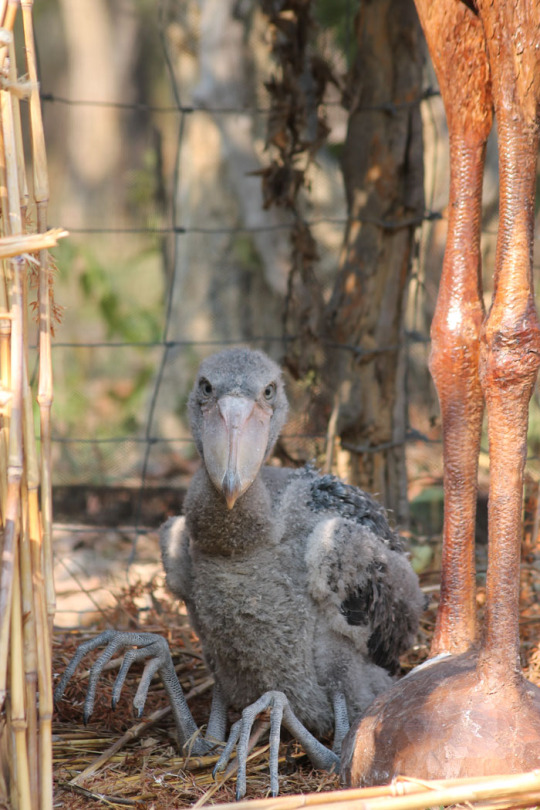
By African Parks/Bengweulu Wetlands Photography
Shoebills begin breeding depending on the water levels of their habitat at a given time. They lay their eggs when the rains begin to end and the waters start to recede; as such, the chicks hatch and fledge late in the dry season. They nest alone, though there are possible reports that they may form some breeding colonies in South Sudan. They make nests out of grass in a mound that is three meters wide, usually placed on a small island or on floating vegetation amongst dense papyrus. They lay two eggs that are incubated for a month. The chickare cute, fluffy, and grey, with tiny regular sized bills. They then fledge a little more than three months later and, what’s more, usually only one chick survives. The chicks and parents will make whining and mewing to each other to get attention and beg for food. Sometimes, the young will make hiccups as begging calls. The parents are constantly with the young for the first forty days of rearing, only briefly leaving to get food and water or nest material. As the chicks age, the parents spend more and more time away, but they still bring food regularly. The chicks, after fledging, remain dependent on the parents for food for a few more years. They reach reproductive age at around three to four years. Displays often including mooing and bill clattering, which can be accompanied by the shaking of the head from side to side, which is quite the undertaking for a bird with such a large head. Breeding pairs stay together for the season, and break up when the chicks leave the nest. Shoebills can live up to fifty years, which is aided by the fact that they tend to not have predators after reaching full size.
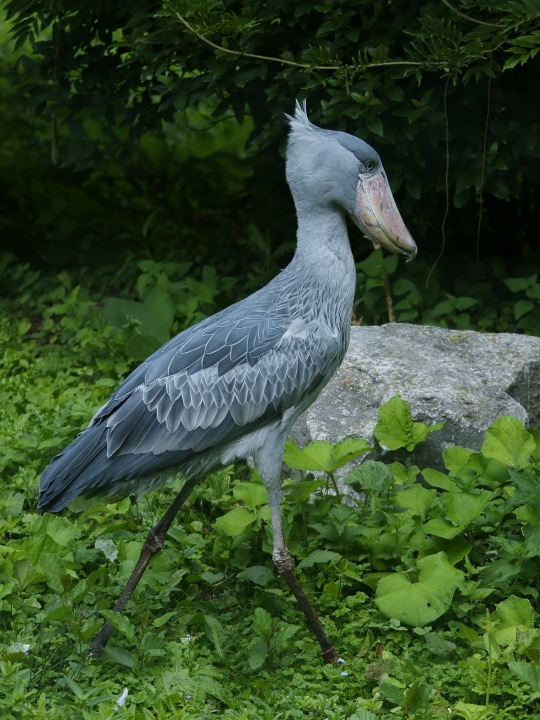
By Hans Hillewaert, CC BY-SA 3.0
Ecosystem: Shoebills stick to marshes, especially papyrus marshes and those with reeds and cattails. They will also gather around marshy lakesides, especially near Lake Victoria. They go wherever they can find floating vegetation to stand upon, including ricefields. They tend to go where animals such as hippopotamus go, since the hippo can dredge up food that the Shoebill can then feed upon.

By Fritz Geller-Grimm, CC BY-SA 2.5
Other: Shoebills are currently considered vulnerable to extinction, with 5000 to 8000 birds thought to be remaining in the wild (though that may be low and there may be as many as 10,000). The reasons for this decline in population is partially due to habitat loss - the Shoebill is dependent on papyrus swamps and other wetland habitats, which are targeted by drainage schemes and other development activities. Animals being brought across these swamps and trampling their young also majorly contributes to population decline. It is a very unique bird and a very popular one, so luckily there are some conservation efforts ongoing, especially in zoos. Some hunting is also contributing to population loss. Despite these conservation efforts, only once has the Shoebill been successfully bred in captivity.
~ By Meig Dickson
Sources under the Cut
Elliott, A., Garcia, E.F.J. & Boesman, P. (2019). Shoebill (Balaeniceps rex). In: del Hoyo, J., Elliott, A., Sargatal, J., Christie, D.A. & de Juana, E. (eds.). Handbook of the Birds of the World Alive. Lynx Edicions, Barcelona.
Guillet, A (1978). "Distribution and Conservation of the Shoebill (Balaeniceps Rex) in the Southern Sudan". Biological Conservation. 13 (1): 39–50.
Hackett, SJ; Kimball, RT; Reddy, S; Bowie, RC; Braun, EL; Braun, MJ; Chojnowski, JL; Cox, WA; Han, KL; et al. (2008). "A phylogenomic study of birds reveals their evolutionary history". Science. 320 (5884): 1763–8.
Hagey, J. R.; Schteingart, C. D.; Ton-Nu, H.-T. & Hofmann, A. F. (2002). "A novel primary bile acid in the Shoebill stork and herons and its phylogenetic significance". Journal of Lipid Research. 43 (5): 685–90.
Hall, Whitmore (1861). The principal roots and derivatives of the Latin language, with a display of their incorporation into English. London: Longman, Green, Longman & Roberts. p. 153.
Hancock & Kushan, Storks, Ibises and Spoonbills of the World. Princeton University Press (1992),
Houlihan, Patrick F. (1986). The Birds of Ancient Egypt. Wiltshire: Aris & Phillips. p. 26.
Jasson, J.; Nahonyo, Cuthbert; Lee, Woo; Msuya, Charles (March 2013). "Observations on nesting of shoebill Balaeniceps rex and wattled crane Bugeranus carunculatus in Malagarasi wetlands, western Tanzania". African Journal of Ecology. 51 (1): 184–187.
Mayr, Gerald (2003). "The phylogenetic affinities of the Shoebill (Balaeniceps rex)". Journal für Ornithologie.
Mikhailov, Konstantin E. (1995). "Eggshell structure in the shoebill and pelecaniform birds: comparison with hamerkop, herons, ibises and storks". Canadian Journal of Zoology. 73 (9): 1754–70.
Muir, Allan; King, C.E. (January 2013). "Management and husbandry guidelines for Shoebills Balaeniceps rex in captivity". International Zoo Yearbook. 47 (1): 181–189.
Stevenson, Terry and Fanshawe, John (2001). Field Guide to the Birds of East Africa: Kenya, Tanzania, Uganda, Rwanda, Burundi. Elsevier Science.
Tomita, Julie (2014). "Challenges and successes in the propagation of the Shoebill Balaeniceps rex: with detailed observations from Tampa's Lowry Park Zoo, Florida". International Zoo Yearbook. 132 (1): 69–82.
Williams, J.G; Arlott, N (1980). A Gield Guide to the Birds of East Africa. Collins.
#Balaeniceps rex#Balaeniceps#Shoebill#Bird#Dinosaur#Birblr#Factfile#Ardeaen#Aequorlitornithian#Water Wednesday#Piscivore#Birds#Dinosaurs#Quaternary#Africa#biology#a dinosaur a day#a-dinosaur-a-day#dinosaur of the day#dinosaur-of-the-day#science#nature
728 notes
·
View notes
Text
Are we reincarnated or recycled after death?
Most of us have read different opinions about death and what happens after death. But there is no positive proof for the existence of souls, immortal karma, reincarnation, or any spiritual after-life. I have nothing but respect for differing views based on religion, science or logic. But eventually truth and understanding will set us free. Not my truth or your truth but real truth…
While all religions admit the existence of soul, but they differ in what happens after death. For example, Hindu concept of soul revolves around transmigration and reincarnation. Muslims and Christians believe in the Day of Judgment when its fate will be decided.
Therefore, the soul of Muslims and Christians is locked in the grave of a person waiting the Day of Judgment when its fate will be decided, whereas the soul of a Hindu who believes in transmigration is immediately released after funeral so that it’s ready to enter into another body.
The question is:
Will God (One and the same God for entire humanity) make two types of souls one for Hindus and other for Muslims and Christians?
Therefore, it is time for scientific evaluation to form a logical opinion, one way or another.
I start with these lines from a scripture of Sikh religion Guru Granth by 5th Guru on death and its standard translation. I share the conclusions at the end.
pavnai meh pavan samaa-i-aa.
The wind merges into the wind.
jotee meh jot ral jaa-i-aa.
The light blends into the light.
maatee maatee ho-ee ayk.
The dust becomes one with the dust.
rovanhaaray kee kavan tayk.
What support is there for the one who is lamenting?
ka-un moo-aa ray ka-un moo-aa.
Who has died? O, who has died?
(Guru Granth: Page: 885, Raag: Raamkalee, Author: Guru Arjan Dev)
Science says the same as religion: We are recycled as the lines from Sikh Scripture Guru Granth say air merges with air, light merges with light, dust settles into dust... We are created from this environment and we go back to the environment.
All matter is a form created from formless Energy, i.e., Him/God/Creator/or whatever other name you like to choose. The creativity is infinite and the method of self-creativity is a real wonder when we look at the creation and growth of living organisms. A scientist cannot deny the feeling of being startled at Nature’s absolutely phenomenal and the most intelligent work of self-creation into all the complicated life forms including a human being through a greatly thoughtful and organized manner.
So, all of us are created out of universal energy and now at the time of death become part of universal energy. Most religions mean the same when life is imagined as a wave arising from the ocean and merging back into it. Viewed this way, reincarnation is a fancy name for recycling. All living organisms get recycled. That’s the law of nature and no one can avoid it.
The basic units of life (electrons, protons, neutrons, atoms and molecules) do not die but change form and rearrange themselves. These basic units of life do not grow old either and are ageless and timeless. The atoms in a child or a seedling are no younger than that of a wrinkled person or a yellowing leaf. So we can say that the soul (part of energy of the universe) never dies but body does. Soul does not die; it does not drown or swim across (na jio marai n doobai tarai (Guru Granth, page 151). The charged particles (electrons, protons, neutrons, atoms and molecules), which are basic units of creation including human body and Soul (atma) are created from and end up with the universal energy (parmatma) that we have explained above as divine force or highest of all or Lord of the Universe or almighty God.... Therefore, the God of which we are part of is universal energy/energy of the universe, because the universe is all energy and the energy is all universe.
In the totality of things reincarnation, rebirth makes absolutely no-sense.
Since matter and energy may change form but are neither created nor destroyed, it means that we will always be around in some shape or form.
Logically, metaphorically reinterpreted, the terms reincarnation and transmigration really mean that after death everyone and every species that exhibits life become part of the greater biological life cycle. That is the logical way to look at birth and rebirth, reincarnation or transmigration.
In this concept of a larger biological life cycle, it remains immaterial whether one ends up pushing up roses or becoming a feeding frenzy for worms; either is equally meaningful. Insects, earth worms and others have roles to play as have plants, trees and rocks.
It's only when we look at life in a specific form then death has a meaning, and we fall victim to our separation from rest of things. That separation is called the ego, generally a product of left hemisphere of brain as opposed to soul which is part of right hemisphere of brain. The ego is a false self that we made up based on the thought that we are separate. That iron curtain of selfish ego separates us from Universal Spirit/Universal Energy or God. Once we accept the God within and realize that it's not possible to be separate from God and that we are one with God; then we know that we are love and we are peace and we are joy and we are happiness and we are eternal; and nothing to wait for after death. It’s realization that happens to some and not to others in this life and nothing to do with after death when each atom of our body merges with the environment and can become part of a plant or an animal or something else.
We have tried to provide alternate views using science and logic to questions that were perceived to be confusing and contradictory varying from faith to faith. The balance of ideas between science and religion is provided as much impartially as humanly possible. We hope these will be more acceptable to our next generation of science and technology. Although it would be wonderful if very religious people would pay attention but I doubt it. Have we settled the discussion on soul and reincarnation? Not likely, even though we have provided very logical answers.
Reference: “Soul and Reincarnation” “Science, Religion & Spirituality”
About the Author: Dr. Sukhraj S. Dhillon is an eminent Scientist with numerous research publications in life sciences who studied at Yale University and served as a Professor at University in North Carolina. He has written more than a dozen books on topics of Health, Aging, Vegetarianism, Weight control, Stress-free living, Meditation, Yoga, Power of Now, Spirituality, Soul, God, Science, and Religion. His articles and books are a pointer to his line of thinking including current publication. He has been the President, Chairman of the board, and life-trustee of a non-profit religious organization and has expressed his views in the congregation and at international seminars. http://www.dpcpress.com/pa.html
https://www.amazon.com/Dr.-Sukhraj-S.-Dhillon/e/B004584DL0
2 notes
·
View notes
Text
Eight Things We’ve Learned About Moms Since the Last Mother's Day
https://sciencespies.com/news/eight-things-weve-learned-about-moms-since-the-last-mothers-day/
Eight Things We’ve Learned About Moms Since the Last Mother's Day

We freewheeling humans may be the only species that reliably showers mothers with cards and confections on the second Sunday in May, but all animal moms deserve some serious love and gratitude—probably on more than an annual basis.
From conception to birth and beyond, moms across the tree of life play an indispensable role in their kids’ survival and success. Here are a few things we’ve learned about the many ways the bong between a mother and her offspring manifests since our last Mother’s Day.
We Still Have a Lot to Learn About the Placenta
A mammalian fetus usually spends a few weeks or months or so in their mother’s placenta, an organ that shuttles nutrients, oxygen and waste between a mom-to-be and her embryo during pregnancy. Understanding this bizarre and complicated bit of anatomy is, quite literally, crucial to comprehending life as we know it.
Plenty about the placenta is still puzzling to researchers, including whether it hosts its own collection of friendly microorganisms, or microbiome. Though microbes are known to quickly colonize both the inside and outside of the human body after birth, playing important roles in immunity, digestion, and more, the placenta has traditionally been considered a sterile spot. If the placental microbiome exists—as some researchers argue it does—it could represent a fetus’ first exposure to benign bacteria and play a role in shaping the child’s future health.
But not everyone is on board with the idea. Last July, a group led by Stephen Charnock-Jones of the University of Cambridge published a study arguing against the existence of this mysterious microbial population, suggesting that previous experiments that had detected it had been the result of contamination in the lab, Laura Sanders reported for Science News at the time. The debate will inevitably rage on, wrote Ed Yong for the Atlantic, but highlights how little we understand about the microbes that inhabit our bodies.
Swamp Wallabies Can Get Pregnant While They’re Already Pregnant
Regardless of whether the placenta teems with bacterial tenants, this organ is inarguably a powerhouse—especially in the swamp wallaby, a petite marsupial that romps around Australia. Thanks to a series of weird quirks in their reproductive cycles, female swamp wallabies can get pregnant while already pregnant. These oddball animals boast two separate uteruses, and can alternate embryo implantations between them, allowing some overlap in gestation if they have sex before giving birth.

Female swamp wallabies may spent their entire adult lives continuously pregnant.
(pen_ash / Pixabay)
“As soon as they reach sexual maturity, these females are—perhaps unfortunately—pregnant all the time,” University of Melbourne biologist Brandon Menzies, who led the team that made the discovery, told Smithsonian magazine earlier this year.
Because their offspring suckle in the pouch for many months after birth, female swamp wallabies can end up supporting three young at once: an older joey that’s left the pouch, but still returns to mom for food; a younger joey nursing inside the pouch; and an incubating fetus that has yet to be born. Now that’s some impressive single parenting.
A 306-million-Year-Old Lizard Mother and Her Child Fossilized Together
The scientific community has learned about a few very old examples motherhood. Among them is a 306-million-year-old fossil immortalizing two lizard-like creatures huddled together in a tree stump—presumably, researchers argue, a mom protecting its kid.
If that’s indeed the case, this rare fossil could represent an extremely ancient instance of parental care in amniotes, the group that includes today’s mammals, birds and reptiles. The behavior, which requires an adult animal to invest time, energy and resources into its offspring after birth, might sound intuitive for modern creatures, but may not have come as easily to our egg-laying predecessors.
“Parental care is a strategy with a long antiquity,” paleontologist Arjan Mann told Smithsonian magazine last year. “Clearly, it’s worked out multiple times in evolutionary history. And we should have an appreciation for it.”
Were Ancient Europeans Using Clay Vessels to Feed Their Infants Animal Milk?
Not quite as old, but perhaps at least as impressive, are a set of 3,000-year-old clay vessels that may have been used to feed babies in what’s now Europe, Bruce Bower reported for Science News in September. Spouted and laced with traces of nonhuman animal milk, the containers may represent rudimentary baby bottles used on young kids during weaning, researchers argued in a paper published last year. By this point in time, dairying in Europe had been in place for at least 3,000 years, and women may have used milk from livestock animals to supplement their own breast milk as their children transitioned to solid food. The findings aren’t definitive, but still offer something for us modernites to chew on.
Mama Whales Whisper to Their Young to Evade Predators
Even when offspring stop relying on their mothers for food, they’ll often turn back to them for comfort, protection and companionship. That concept isn’t exactly breaking news, but each passing year offers up new examples of the tender ties between parents and their progeny.
Last July, Carolyn Wilke at Science News wrote of a heartwarming ritual between female southern right whales and their calves, who will listen to their mothers’ soft whispers to evade predatory orcas. These gentle calls—which sound like baritone moos—are too quiet to be picked up by anyone other than an adjacent whale (and, in this case, an eavesdropping scientist), allowing the gentle giants to protect their little ones in the vast and dangerous sea. “This shows us that whales have a sort of intimate communication as well,” Mia Nielsen, a behavioral biologist at Aarhus University in Denmark, told Science News at the time.
Vampire Bat Moms Persevere Through Illness to Care for Their Young
Moms will also go to great—and probably unsurprisingly—lengths to care for their kids, even when they’re feeling under the weather, a recent find in vampire bats suggests. Despite their vilification as blood sucking antagonists, these flying mammals are intelligent, social and generous, ecologist Gerry Carter of Ohio State University told Smithsonian magazine earlier this year. Sickness and symptoms do change behaviors, but illness-stricken moms will still muster the energy to feed and groom their offspring, highlighting the resilience of these relationships. The flipside of this, of course, is that it may enable infectious diseases to spread more quickly through family groups.
A Dolphin Adopted an Orphaned Baby Whale
A few heroic animal moms will even extend their caregiving to younguns of other species. Such adoptions are extremely rare (and don’t always end well). But recently, scientists have stumbled upon a handful of examples, including a female bottlenose dolphin that spent more than three years caring for a young melon-headed whale—even though she already had her own biological baby.
For mammals, milk production is a costly endeavor, making most moms wary of investing in young they’re not related to, even within the same species. The researchers behind the discovery, described in a paper published last summer, aren’t sure what circumstances bore out this odd cross-species interaction, but suspect it may have been largely fortuitous. Perhaps the little melon-headed whale was particularly persistent in pursuing the bottlenose mom at a time when she was “permissive” to the idea, having just given birth herself, Pamela Carzon of the Groupe d’Étude des Mammifères Marins (GEMM) de Polynésie told Erica Tennenhouse at National Geographic at the time.
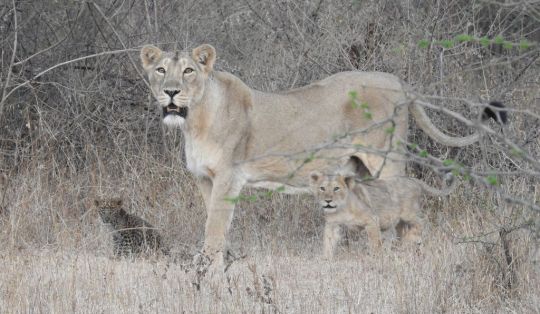
A mother lion, her lion cubs and her adopted spotted leopard baby.
(Dheeraj Mittal / Deputy Conservator of Forests in India)
A Lioness Cared for a Sick Baby Leopard
Even more unexpected was a bond that formed between a mother lion and a baby leopard, described in a paper published earlier this year. Natural competitors who typically tussle over space and resources in India’s Gir National Park, lions and leopards are “at perpetual odds,” Stotra Chakrabarti of the University of Minnesota told Cara Giaimo at the New York Times. But a fuzzy, blue-eyed leopard cub managed to manage to melt another big cat’s lion heart. For more than a month, the lioness fostered the little interloper before he sadly died from a condition he’d likely had since birth.
The melon-headed whale and the leopard represent only the second and third cases of interspecies adoption ever documented, following on the heels of 2004 observation of a group of capuchin monkeys sheltering an infant marmoset. In all cases, the adoptee seemed to fit in relatively seamlessly with its new family, sometimes even engaging in playful behaviors and mimicking its newfound siblings.
These events are notably for their scarcity—but they’re also just plain adorable. As Carzon told National Geographic, “We were really excited to be able to witness such a rare phenomenon.”
#News
1 note
·
View note
Text
Sending American Astronauts to Moon in 2024: NASA Accepts Challenge
NASA logo. April 15, 2019 The president directed NASA to land American astronauts on the Moon by 2024, and the agency is working to accelerate humanity’s return to the lunar surface by all means necessary. “We’ve been given an ambitious and exciting goal. History has proven when we’re given a task by the president, along with the resources and the tools, we can deliver,” said NASA Administrator Jim Bridenstine. “We are committed to making this happen. We have the people to achieve it. Now, we just need bipartisan support and the resources to get this done.” Bridenstine confirmed at the 35th Space Symposium on April 9, 2019, that the agency’s proposed human lunar landing system architecture remains the plan to return crew to the surface as quickly as possible. The human lunar lander will be a public-private partnership working directly with American companies to expedite the return of Astronauts to the Moon’s surface by 2024. The South Pole continues to be the target of our exploration.
American Astronauts (comeback's) on the Moon. Image Credit: NASA
In order to best accomplish our goals in the next five years, NASA is now going forward to the Moon in two phases. “First, we are focused on speed to land the next man, and first woman, on the Moon by 2024. Second, we will establish sustainable missions by 2028. To do that, we need our powerful Space Launch System to put the mass of reusable systems into deep space,” he said. Gateway to Lunar Surface Both phases rely on the Gateway, which will serve as a reusable command and service module in lunar orbit. Initial development for the lunar outpost calls for a power and propulsion element plus a habitation capability to support access to the surface. “The Gateway can be positioned in a variety of orbits around the Moon, allows for access to entire lunar surface, and supports development of a reusable human lander system,” said William Gerstenmaier, associate administrator for Human Exploration and Operations Mission Directorate at NASA Headquarters. “Resiliency and reusability are key for sustainable human lunar exploration, and that’s what the Gateway gives us. Furthermore, there’s broad interest from the international community for supporting as well.” This is how the human lunar lander system would operate from the Gateway: - A transfer element drives the combined ascent and descent elements with crew inside the ascent element from the Gateway to low-lunar orbit. - From that orbit, crew will use the descent element to land on the surface. - When astronauts complete their expedition, they take the ascent element back up to the Gateway. During lunar expeditions, a team of crew members will remain aboard the Gateway for scientific investigations while a separate team will explore the surface. All crew members ultimately board the Orion spacecraft for a return to Earth. NASA is already working with U.S. industry to study a transfer element, descent element and refueling systems for use with the lunar Gateway, and begin early development work. A similar request for the ascent element was accelerated to meet the new direction, and a synopsis was issued April 8 to industry. A formal request for proposals will be released in the near future. New Lunar Science, Technology NASA will soon begin sending science and technology investigations to the lunar surface through its Commercial Lunar Payload Services (CLPS). By the time NASA sends crew to the Moon, many CLPS deliveries will be complete, with the first one happening by the end of this year if a commercial lander is ready. “Using new landers, robots and eventually humans, we will conduct science and technology demonstrations across the entire lunar surface of the Moon to learn more about resources on the Moon and how we can use them for future exploration,” said Bridenstine. “We will move forward to the Moon, this time to stay. And then we’ll take what we learn on the Moon, and go to Mars.” The president’s direction from Space Policy Directive-1 galvanizes NASA’s return to the Moon and builds on progress on the Space Launch System rocket and Orion spacecraft, collaborations with U.S industry and international partners, and knowledge gained from current robotic assets at the Moon and Mars. Related articles: Moon’s South Pole in NASA’s Landing Sites https://orbiterchspacenews.blogspot.com/2019/04/moons-south-pole-in-nasas-landing-sites.html Gateway to the Moon https://orbiterchspacenews.blogspot.com/2019/03/gateway-to-moon.html Goddard Technologists and Scientists Prepare for a New Era of Human Exploration https://orbiterchspacenews.blogspot.com/2019/03/goddard-technologists-and-scientists.html NASA Seeks US Partners to Develop Reusable Systems to Land Astronauts on Moon https://orbiterchspacenews.blogspot.com/2018/12/nasa-seeks-us-partners-to-develop.html Related links: Human lunar landing system architecture: https://www.nasa.gov/feature/nasa-seeks-us-partners-to-develop-reusable-systems-to-land-astronauts-on-moon Space Launch System (SLS): http://www.nasa.gov/sls Commercial Lunar Payload Services (CLPS): https://www.nasa.gov/content/commercial-lunar-payload-services Lunar Orbital Platform-Gateway: https://www.nasa.gov/topics/moon-to-mars/lunar-outpost Space Policy Directive-1: https://www.nasa.gov/press-release/new-space-policy-directive-calls-for-human-expansion-across-solar-system For more information about NASA’s Moon to Mars exploration plans, visit: https://www.nasa.gov/moontomars Image (mentioned), Text, Credits: NASA/Erin Mahoney. Best regards, Orbiter.ch Full article
54 notes
·
View notes